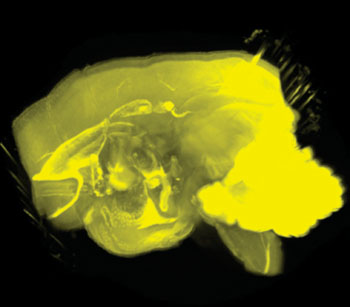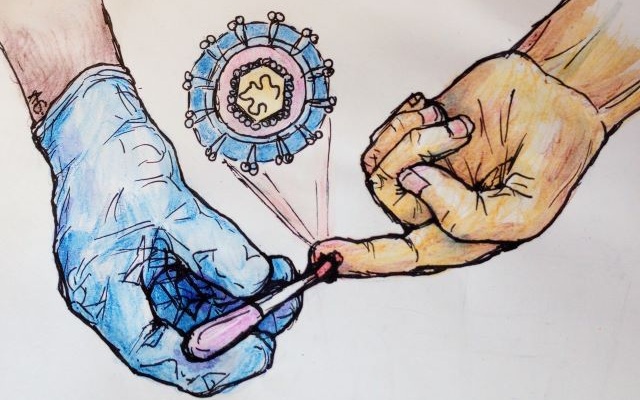Scientists Achieve Rapid Whole-Brain Imaging with Single Cell Resolution
|
By LabMedica International staff writers Posted on 15 Jun 2014 |

Image: Marmoset brain created using the CUBIC method (Photo courtesy of RIKEN).
An intensive effort has been made, particularly in the brain, to determine how neural activity is converted into consciousness and other complicated brain activities. A new high-throughput technology called CUBIC (clear, unobstructed brain imaging cocktails and computational analysis) appears to be a giant leap forward, as it offers unprecedented rapid whole-brain imaging at single cell resolution with a straightforward protocol to clear and make the brain sample transparent based on the use of amino-alcohols.
A key problem of systems biology is determining how phenomena at the cellular scale correlate with activity at the organism level. One example of the technologies that may provide better understanding of these phenomena is whole-brain imaging at single-cell resolution. This imaging typically involves preparing a highly transparent sample that minimizes light scattering and then imaging neurons tagged with fluorescent probes at different slices to generate a three-dimensional (3D) representation. However, limitations in current techniques prevent comprehensive study of the relationship. The project’s findings were published April 24, 2014, in the journal Cell.
In combination with light sheet fluorescence microscopy, CUBIC was evaluated for rapid imaging of a number of mammalian systems, such as mouse and primate, demonstrating its scalability for brains of different size. Moreover, it was used to acquire new spatial-temporal details of gene expression patterns in the hypothalamic circadian rhythm center. Moreover, by combining images captured from opposite directions, CUBIC enables whole brain imaging and direct comparison of brains in diverse environmental settings.
CUBIC tackles a number of obstacles compared with earlier strategies. One is the clearing and transparency protocol, which involves serially immersing fixed tissues into just two reagents for a comparatively short time. Second, CUBIC is compatible with many fluorescent probes because of low quenching, which allows for probes with longer wavelengths and lessens concern for scattering when whole brain imaging, while at the same time provides multicolor imaging. Lastly, it is highly reproducible and scalable. Whereas other approaches have achieved some of these abilities, CUBIC is the first to accomplish it all.
CUBIC provides data on earlier unattainable 3D gene expression profiles and neural networks at the systems level. Because of its rapid and high-throughput imaging, CUBIC offers an amazing opportunity to study localized effects of genomic editing. It also is expected to identify neural connections at the whole brain level. Last author Dr. Hiroki Ueda, from RIKEN (Saitama, Japan) is excited about further applications to even larger mammalian systems. “In the near future, we would like to apply CUBIC technology to whole-body imaging at single cell resolution.”
Related Links:
RIKEN
A key problem of systems biology is determining how phenomena at the cellular scale correlate with activity at the organism level. One example of the technologies that may provide better understanding of these phenomena is whole-brain imaging at single-cell resolution. This imaging typically involves preparing a highly transparent sample that minimizes light scattering and then imaging neurons tagged with fluorescent probes at different slices to generate a three-dimensional (3D) representation. However, limitations in current techniques prevent comprehensive study of the relationship. The project’s findings were published April 24, 2014, in the journal Cell.
In combination with light sheet fluorescence microscopy, CUBIC was evaluated for rapid imaging of a number of mammalian systems, such as mouse and primate, demonstrating its scalability for brains of different size. Moreover, it was used to acquire new spatial-temporal details of gene expression patterns in the hypothalamic circadian rhythm center. Moreover, by combining images captured from opposite directions, CUBIC enables whole brain imaging and direct comparison of brains in diverse environmental settings.
CUBIC tackles a number of obstacles compared with earlier strategies. One is the clearing and transparency protocol, which involves serially immersing fixed tissues into just two reagents for a comparatively short time. Second, CUBIC is compatible with many fluorescent probes because of low quenching, which allows for probes with longer wavelengths and lessens concern for scattering when whole brain imaging, while at the same time provides multicolor imaging. Lastly, it is highly reproducible and scalable. Whereas other approaches have achieved some of these abilities, CUBIC is the first to accomplish it all.
CUBIC provides data on earlier unattainable 3D gene expression profiles and neural networks at the systems level. Because of its rapid and high-throughput imaging, CUBIC offers an amazing opportunity to study localized effects of genomic editing. It also is expected to identify neural connections at the whole brain level. Last author Dr. Hiroki Ueda, from RIKEN (Saitama, Japan) is excited about further applications to even larger mammalian systems. “In the near future, we would like to apply CUBIC technology to whole-body imaging at single cell resolution.”
Related Links:
RIKEN
Latest BioResearch News
- Genome Analysis Predicts Likelihood of Neurodisability in Oxygen-Deprived Newborns
- Gene Panel Predicts Disease Progession for Patients with B-cell Lymphoma
- New Method Simplifies Preparation of Tumor Genomic DNA Libraries
- New Tool Developed for Diagnosis of Chronic HBV Infection
- Panel of Genetic Loci Accurately Predicts Risk of Developing Gout
- Disrupted TGFB Signaling Linked to Increased Cancer-Related Bacteria
- Gene Fusion Protein Proposed as Prostate Cancer Biomarker
- NIV Test to Diagnose and Monitor Vascular Complications in Diabetes
- Semen Exosome MicroRNA Proves Biomarker for Prostate Cancer
- Genetic Loci Link Plasma Lipid Levels to CVD Risk
- Newly Identified Gene Network Aids in Early Diagnosis of Autism Spectrum Disorder
- Link Confirmed between Living in Poverty and Developing Diseases
- Genomic Study Identifies Kidney Disease Loci in Type I Diabetes Patients
- Liquid Biopsy More Effective for Analyzing Tumor Drug Resistance Mutations
- New Liquid Biopsy Assay Reveals Host-Pathogen Interactions
- Method Developed for Enriching Trophoblast Population in Samples
Channels
Clinical Chemistry
view channel
Blood Test Could Predict and Identify Early Relapses in Myeloma Patients
Multiple myeloma is an incurable cancer of the bone marrow, and while many patients now live for more than a decade after diagnosis, a significant proportion relapse much earlier with poor outcomes.... Read more
Compact Raman Imaging System Detects Subtle Tumor Signals
Accurate cancer diagnosis often depends on labor-intensive tissue staining and expert pathological review, which can delay results and limit access to rapid screening. These conventional methods also make... Read moreMolecular Diagnostics
view channel
Blood Test Combined with MRI Brain Scans Reveals Two Distinct Multiple Sclerosis Types
Multiple sclerosis (MS) affects more than 2.8 million people worldwide, yet predicting how the disease will progress in individual patients remains difficult. Current MS classifications are based on clinical... Read more
Ultra-Sensitive Blood Biomarkers Enable Population-Scale Insights into Alzheimer’s Pathology
Accurately estimating how many people carry Alzheimer’s disease pathology has long been a challenge, as traditional methods rely on small, clinic-based samples rather than the general population.... Read more
Blood Test Could Predict Death Risk in World’s Most Common Inherited Heart Disease
Hypertrophic cardiomyopathy (HCM) is the world’s most common inherited heart condition and affects millions of people globally. While some patients live with few or no symptoms, others develop heart failure,... Read moreHematology
view channel
MRD Tests Could Predict Survival in Leukemia Patients
Acute myeloid leukemia is an aggressive blood cancer that disrupts normal blood cell production and often relapses even after intensive treatment. Clinicians currently lack early, reliable markers to predict... Read more
Platelet Activity Blood Test in Middle Age Could Identify Early Alzheimer’s Risk
Early detection of Alzheimer’s disease remains one of the biggest unmet needs in neurology, particularly because the biological changes underlying the disorder begin decades before memory symptoms appear.... Read more
Microvesicles Measurement Could Detect Vascular Injury in Sickle Cell Disease Patients
Assessing disease severity in sickle cell disease (SCD) remains challenging, especially when trying to predict hemolysis, vascular injury, and risk of complications such as vaso-occlusive crises.... Read more
ADLM’s New Coagulation Testing Guidance to Improve Care for Patients on Blood Thinners
Direct oral anticoagulants (DOACs) are one of the most common types of blood thinners. Patients take them to prevent a host of complications that could arise from blood clotting, including stroke, deep... Read moreImmunology
view channel
Ultrasensitive Liquid Biopsy Demonstrates Efficacy in Predicting Immunotherapy Response
Immunotherapy has transformed cancer treatment, but only a small proportion of patients experience lasting benefit, with response rates often remaining between 10% and 20%. Clinicians currently lack reliable... Read more
Blood Test Could Identify Colon Cancer Patients to Benefit from NSAIDs
Colon cancer remains a major cause of cancer-related illness, with many patients facing relapse even after surgery and chemotherapy. Up to 40% of people with stage III disease experience recurrence, highlighting... Read moreMicrobiology
view channel
New UTI Diagnosis Method Delivers Antibiotic Resistance Results 24 Hours Earlier
Urinary tract infections affect around 152 million people every year, making them one of the most common bacterial infections worldwide. In routine medical practice, diagnosis often relies on rapid urine... Read more
Breakthroughs in Microbial Analysis to Enhance Disease Prediction
Microorganisms shape human health, ecosystems, and the planet’s climate, yet identifying them and understanding how they are related remains a major scientific challenge. Even with modern DNA sequencing,... Read morePathology
view channel
Genetics and AI Improve Diagnosis of Aortic Stenosis
Aortic stenosis is a progressive narrowing of the aortic valve that restricts blood flow from the heart and can be fatal if left untreated. There are currently no medical therapies that can prevent or... Read more
AI Tool Simultaneously Identifies Genetic Mutations and Disease Type
Interpreting genetic test results remains a major challenge in modern medicine, particularly for rare and complex diseases. While existing tools can indicate whether a genetic mutation is harmful, they... Read more
Rapid Low-Cost Tests Can Prevent Child Deaths from Contaminated Medicinal Syrups
Medicinal syrups contaminated with toxic chemicals have caused the deaths of hundreds of children worldwide, exposing a critical gap in how these products are tested before reaching patients.... Read more
Tumor Signals in Saliva and Blood Enable Non-Invasive Monitoring of Head and Neck Cancer
Head and neck cancers are among the most aggressive malignancies worldwide, with nearly 900,000 new cases diagnosed each year. Monitoring these cancers for recurrence or relapse typically relies on tissue... Read moreTechnology
view channel
Pioneering Blood Test Detects Lung Cancer Using Infrared Imaging
Detecting cancer early and tracking how it responds to treatment remains a major challenge, particularly when cancer cells are present in extremely low numbers in the bloodstream. Circulating tumor cells... Read more
AI Predicts Colorectal Cancer Survival Using Clinical and Molecular Features
Colorectal cancer is one of the most common and deadly cancers worldwide, and accurately predicting patient survival remains a major clinical challenge. Traditional prognostic tools often rely on either... Read moreIndustry
view channel
BD and Penn Institute Collaborate to Advance Immunotherapy through Flow Cytometry
BD (Becton, Dickinson and Company, Franklin Lakes, NJ, USA) has entered into a strategic collaboration with the Institute for Immunology and Immune Health (I3H, Philadelphia, PA, USA) at the University... Read more




















